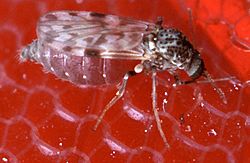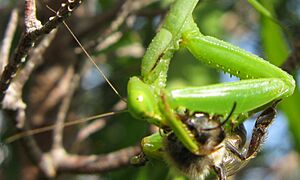Midge facts for kids
Quick facts for kids Midges |
|
|---|---|
 |
|
| A biting midge feeding on blood through an artificial membrane for insect rearing | |
| Scientific classification | |
| Kingdom: | |
| Phylum: | |
| Class: | |
| Order: | |
| Suborder: | |
A midge is a common name for many types of small fly. These tiny insects are all part of a larger group called Nematocera. Think of it like a big family tree for insects!
Midges live almost everywhere on Earth. You can find them in most land areas. The only places they usually don't live are very dry deserts or places that are frozen all the time.
Where Do Midges Live?
Midges are very adaptable creatures. They can be found in many different habitats. Some types of midges prefer wet areas. These include fens, bogs, and marshes. They are especially common in these damp places.
For example, the highland midge of Scotland (Culicoides impunctatus) is famous. It lives in huge numbers in Scotland. This midge is known for biting and sucking blood. It is a big pest in the Scottish uplands and lowlands. You can find them from late spring to late summer.
Different Kinds of Midges
There are many different kinds of midges. Their habits can be very different from one species to another. However, midges within the same family usually act in similar ways. They often play similar roles in their environment.
Here are some examples of midge families:
- Blephariceridae: These are known as net-winged midges.
- Cecidomyiidae: These are called gall midges. They often cause plants to grow strange bumps called galls.
- Ceratopogonidae: These are the biting midges. They are also known as "no-see-ums" or "punkies" in North America. In Australia, they are sometimes called sandflies.
- Chaoboridae: These are phantom midges.
- Chironomidae: These are non-biting midges. They are sometimes called "muffleheads" near the Great Lakes in North America.
- Deuterophlebiidae: These are mountain midges.
- Dixidae: These are meniscus midges.
- Scatopsidae: These are dung midges.
- Thaumaleidae: These are solitary midges.
Midges and Their Role in Nature
Midges play different roles in nature. Some midges are very important. They can be vectors for various diseases. This means they can carry and spread illnesses. For example, some Phlebotominae (like sand flies) and Simuliidae (black flies) can spread diseases.
On the other hand, many midges are a food source. They are eaten by insectivores. These are animals that eat insects. For instance, various frogs and swallows often eat midges. This makes midges an important part of the food web.


